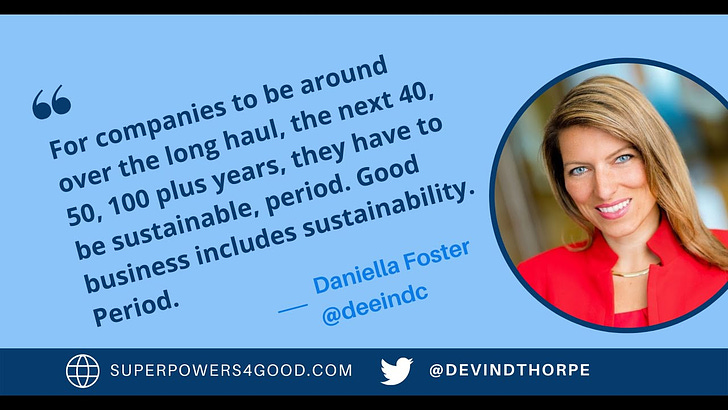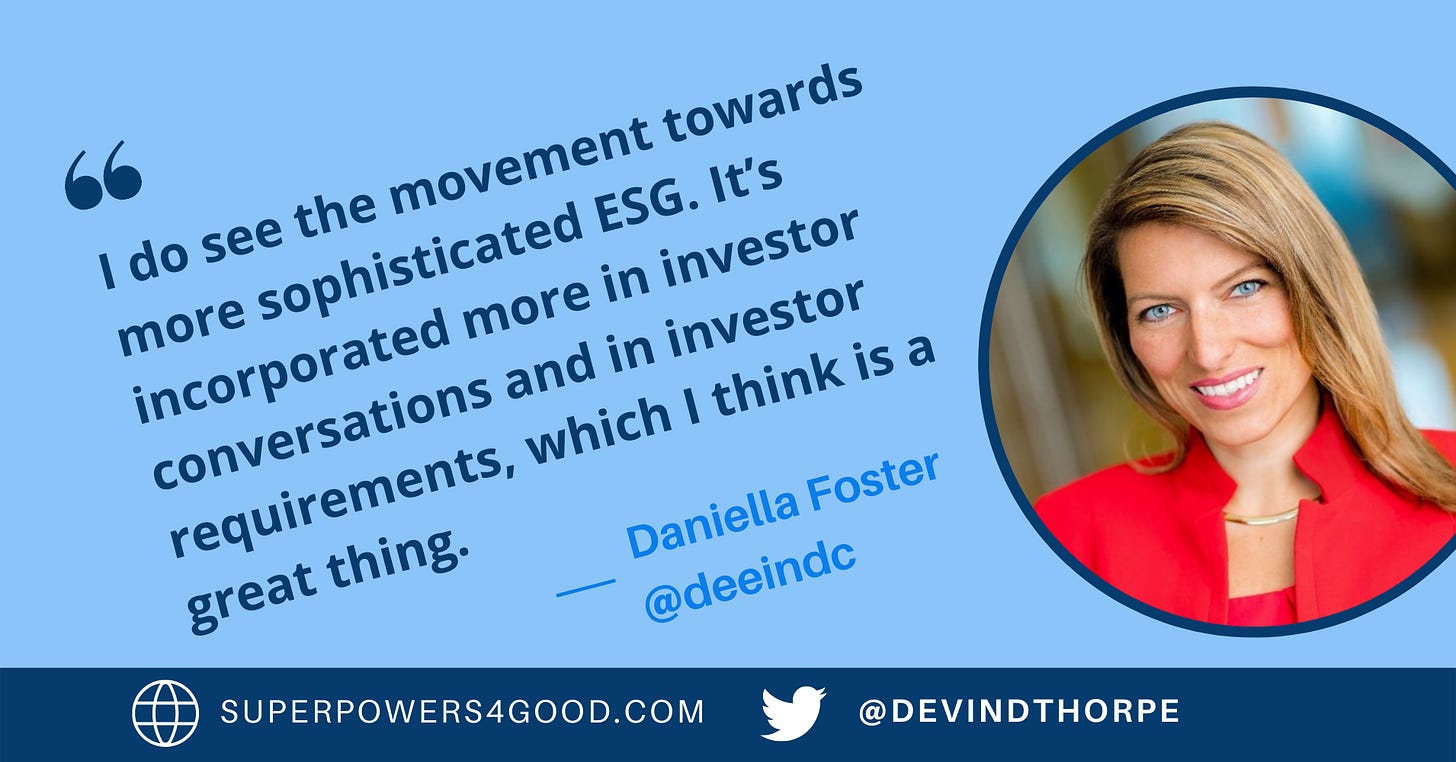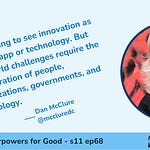Devin: What do you think of as your superpower?
Daniella: Yeah. So I was reflecting on this a bit. I think my superpower is actually resilience.
“Part of why I took this role is we have an ambition to expand access to everyday health for one hundred million people, particularly with a focus on underserved communities,” Daniella Foster said. She explained her decision to accept the position of global vice president and head of public affairs, science and sustainability for Bayer’s consumer health division.
While she took the position before COVID, she sees the pandemic as increasing her motivation to execute on the mission.
She is also excited about the company’s environmental goals, becoming “climate neutral by 2030, going net-zero by 2050,” she said, adding, “And also, we recently announced last month a $100 million investment in sustainable solutions.”
Daniella is pleased by the growing attention on sustainability and social responsibility. “I do see the movement towards more sophisticated ESG. It’s incorporated more in investor conversations and in investor requirements, which I think is a great thing.”
“The bar is continually getting set higher and increasingly, especially when we talk about climate,” she said. “These are science-based conversations, and I think that’s critical.”
Daniella sees sustainability as a competitive advantage. “For companies to be around over the long haul, the next 40, 50, 100 plus years, they have to be sustainable, period. Good business includes sustainability. Period.”
She explained Bayer’s initiatives to meet its ambitious public health improvement goals. “It’s everything from expanding access to modern-day family planning and contraceptives for one hundred million women in low and middle-income countries on through to improving the livelihoods of smallholder farmers. One hundred million smallholder farmers in low and middle-income countries.”
One single effort is called the nutrient gap initiative. “The goal there is to expand access to vital vitamins and minerals for 50 million people in underserved communities by 2030,” Daniella said.
The benefits of nutrition go beyond health. “If you set a child up with the best start in life with the appropriate prenatal and the nutrients they need, it’s one of the key tools to helping to break the cycle of poverty.”
There are three parts to the program.
The first part is to provide nutritional products. Bayer partners with the nonprofit Vitamin Angels to help community health providers give a 180-day supplement program to expecting mothers.
The second part is health education and literacy. This effort focuses long-term on embedding it into the health care system for maternal care.
Finally, the third piece is advocacy. Bayer is working to influence global policy using a collective action approach with governments and NGOs. “We saw a fantastic example of that last year when the World Health Organization added multiple micronutrient supplements to their list of essential medicines,” Daniella said.
Circling back to environmental stewardship, Daniella explained the distinction between Bayer’s goal to be “climate neutral by 2030” and “net-zero by 2050.” The shorter-term goal is focused on its own carbon footprint, measuring only its direct activities. The longer-term goal is to work with all its suppliers to reach net-zero, including the entire supply chain.
Daniella practically gushes with enthusiasm for Bayer’s commitment to sustainability:
If I think about what attracted me to Bayer it was the level of seriousness that we have around this. It's taken up at the board of management at the highest levels of our business. We bake it into our incentive plans and structures. We measure it on par with our financial metrics. So in many ways, it's not a separate standalone sustainability project that we do on the side. It's a core part of our business and that's where I actually think sustainability needs to move.
Recognizing, however, that achieving ambitious goals is inherently complex and that the goals will, in some cases, take decades to accomplish, she sees her superpower, resilience, as an essential part of her eventual success.
How to Develop Resilience As a Superpower
Daniella introduced her thinking about resilience with an analogy:
I had set out at one point to start to do triathlons, many sprint triathlons. And when I set out on that ambition, I actually didn't know how to swim, at least in the formal way with the with the bilateral breathing and the formal freestyle, right? But I set out to do it. That was my goal. And when I would go in to do these triathlons, you have your three legs of the triathlon. On the first leg, everyone swims. Everyone would pass me consistently across the board. Then I'd get to the bike. I was probably a below average biker. Still, people would pass me, but a little bit less. Then you'd get into the final round, which was your run. And I'm also probably an average runner, right? But that's where I would really kick into gear. I'd pick up my momentum and I'd sprint towards the finish line and I even made it on the podium once.
It is clear that for Daniella, resilience is more than enduring what life throws at you. It is about working toward something that matters. “I like to set big long-term goals that are actionable,” she said.
“I also think resilience has passion in it, too,” suggesting that passion is part of what forms the resilience to stick to a goal until it you accomplish it.
“This is about change management. So you have to bring people along with you. You have to be agile; you have to have the agility to know when you go from plan A to plan B to plan C to plan D,” Daniella said, making the case that agility is part of her resilience.
She also made the case for perspective as a fundamental part of resilience:
I've been in the sustainability and ESG space for over a decade now, and some of the things that a decade ago we were talking about are now coming to fruition and we're starting to see ESG more incorporated into the investor space. So I think one of the things I've learned over time is perspective. Sometimes you have to wait to hit those big goals, but that doesn't mean you don't still go after them, and it doesn't mean you don't ride out the tough times.
Surprising me a bit, she sees listening and empathy as a part of the formula for resilience.
You could have complete resilience to keep going, but if you can't influence and influence in some cases without authority, you're really not going to get anywhere. And that comes with listening, empathy and meeting people where they are to really understand the challenges and roadblocks and how you move through those while building trust and while making progress on your goal.
After reflecting on this observation, I think it is profoundly powerful to think of empathy as part of resilience.
Recapping, we can see her resilience is built on five fundamental principles:
Set actionable, ambitious goals
Channel your passion.
Be agile.
Maintain perspective.
Meet people where they are.
By following these principles, you can make resilience a superpower that will help you accomplish your biggest goals.

























Bayer's Goal to Expand Basic Health Care to 100 Million Underserved